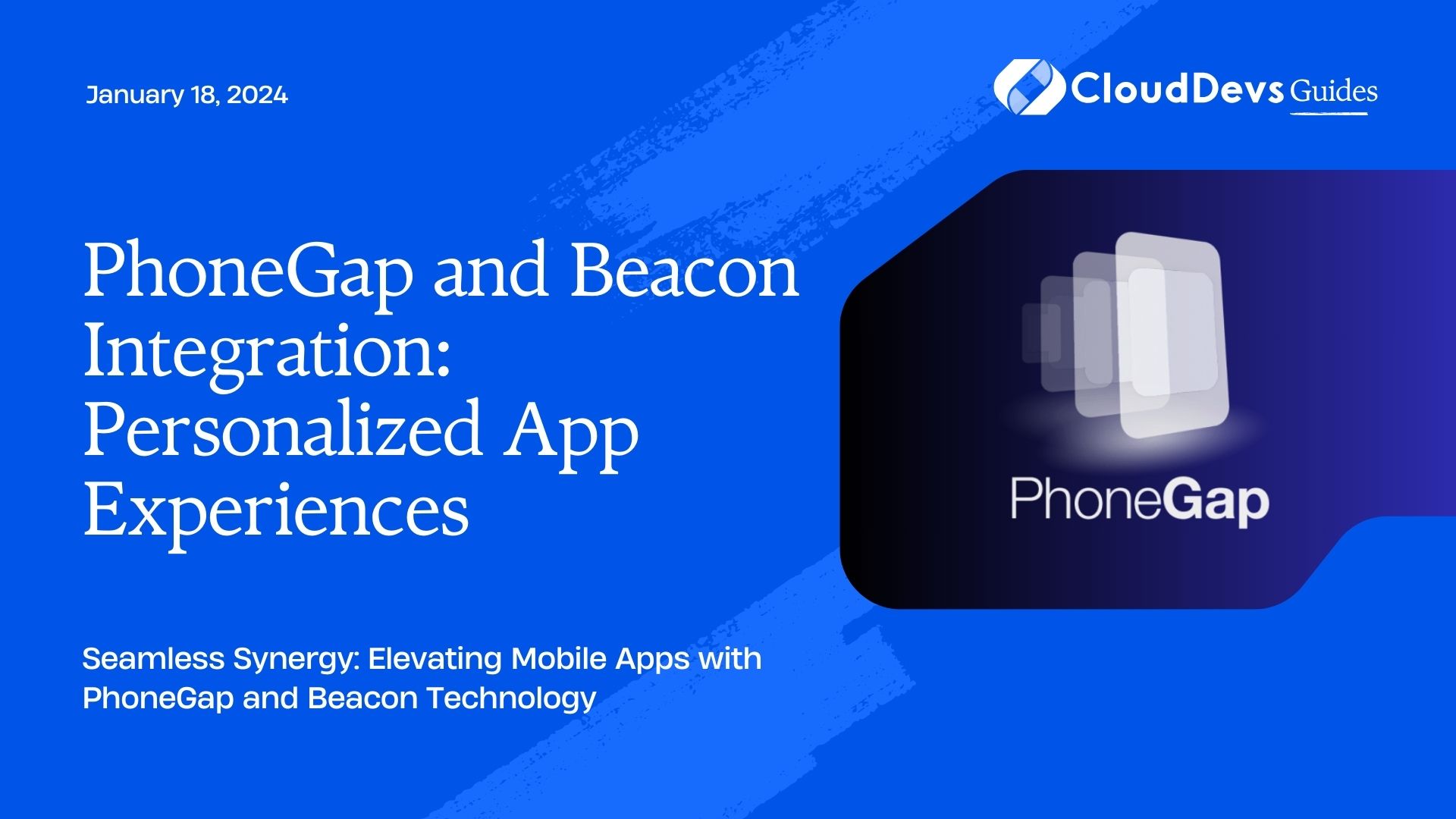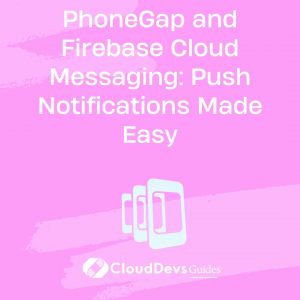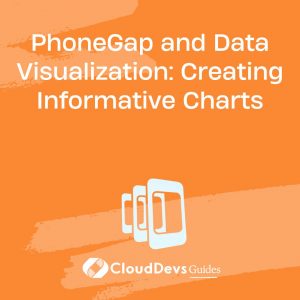PhoneGap and Beacon Integration: Personalized App Experiences
In a world where mobile applications dominate the digital landscape, user experience has become the paramount concern for app developers. Users now expect personalized, context-aware interactions that cater to their specific needs and preferences. Enter Beacon technology, a game-changer in creating such personalized experiences. When combined with PhoneGap, a versatile mobile app development framework, the possibilities are endless. In this blog, we will delve into the fusion of PhoneGap and Beacon technology and explore how it can transform your app into a user-centric powerhouse.
1. Understanding PhoneGap
Before we dive into the integration of PhoneGap and Beacon, let’s briefly understand what each of these technologies brings to the table.
1.1. PhoneGap: A Cross-Platform Development Framework
PhoneGap, now known as Apache Cordova, is an open-source mobile app development framework that allows developers to create cross-platform applications using web technologies such as HTML, CSS, and JavaScript. With PhoneGap, developers can write code once and deploy it across multiple platforms, including iOS, Android, and Windows, reducing development time and effort.
1.2. Beacon Technology: The Contextual Trigger
Beacon technology, on the other hand, involves small, wireless devices called beacons that transmit Bluetooth Low Energy (BLE) signals. These signals are picked up by mobile devices in close proximity, enabling location-based interactions and context-aware experiences. Beacons have found applications in various industries, including retail, healthcare, and tourism, as they enable personalized engagement with users based on their physical location.
Now that we have a basic understanding of both PhoneGap and Beacon technology, let’s explore how integrating these two can enhance app experiences.
2. The Power of PhoneGap and Beacon Integration
Integrating PhoneGap with Beacon technology offers several advantages that can transform your app into a dynamic, context-aware platform. Here are some key benefits:
2.1. Proximity-Based Features
Beacons emit signals that can be detected by nearby mobile devices, allowing your app to respond to a user’s proximity to specific locations. This opens up possibilities for creating location-specific content, offers, and notifications. For example, a retail app can provide special discounts when a user is near a physical store, enticing them to make a purchase.
javascript
// Sample JavaScript code to detect a beacon in PhoneGap
document.addEventListener('deviceready', function() {
cordova.plugins.locationManager.startRangingBeaconsInRegion(beaconRegion)
.fail(console.error)
.done();
}, false);
2.2. Personalized Recommendations
By analyzing user behavior and preferences in various locations, your app can deliver personalized recommendations. For instance, a museum app can suggest specific exhibits based on a visitor’s previous interests and the exhibits they are currently near.
javascript
// Sample code for delivering personalized recommendations
function getRecommendations(userLocation, userInterests) {
// Logic to generate personalized recommendations
// based on location and user interests
}
2.3. Enhanced Navigation
Beacons can also assist in indoor navigation by providing real-time guidance within large facilities like airports, shopping malls, or hospitals. Users can receive step-by-step directions on their mobile devices, making it easier for them to reach their desired destinations.
javascript
// Sample code for indoor navigation using beacons
function navigateToDestination(destinationLocation) {
// Logic to provide turn-by-turn directions
// based on beacon signals and user location
}
2.4. Improved User Engagement
By delivering contextually relevant content and notifications, you can boost user engagement. Users are more likely to interact with an app that understands their current context and offers valuable information or promotions.
javascript
// Sample code for sending context-aware notifications
function sendContextualNotification(message, userLocation) {
// Logic to determine when and where to send notifications
}
2.5. Data Analytics
Integrating Beacon technology allows you to collect valuable data on user behavior, including their movement patterns, interests, and dwell times in specific locations. This data can be analyzed to gain insights into user preferences and optimize your app further.
javascript
// Sample code for collecting and analyzing beacon data
function collectAndAnalyzeData(userData) {
// Logic to gather and analyze user behavior data
}
3. Steps to Integrate PhoneGap and Beacon Technology
Now that you understand the benefits of integrating PhoneGap and Beacon technology, let’s walk through the steps to achieve this integration:
3.1. Set Up Your PhoneGap Project
If you haven’t already, create a PhoneGap project using the PhoneGap CLI or your preferred development environment. Make sure your project is configured for the target platforms (e.g., iOS and Android).
bash phonegap create my-beacon-app cd my-beacon-app phonegap platform add ios phonegap platform add android
3.2. Install Beacon Plugins
PhoneGap offers various plugins to interact with Bluetooth and Beacon devices. You can use plugins like “cordova-plugin-ibeacon” or “cordova-plugin-bluetoothle” to facilitate communication with beacons.
bash phonegap plugin add cordova-plugin-ibeacon
3.3. Implement Beacon Functionality
Write JavaScript code to interact with the beacon devices. This code should include functions for detecting nearby beacons, calculating proximity, and triggering actions based on beacon signals.
javascript
// Sample JavaScript code for beacon functionality
document.addEventListener('deviceready', function() {
// Initialize beacon detection
cordova.plugins.locationManager.startRangingBeaconsInRegion(beaconRegion)
.fail(console.error)
.done();
// Handle beacon proximity changes
cordova.plugins.locationManager.setDelegate(delegate);
function delegate(pluginResult) {
// Handle beacon events and proximity changes
}
}, false);
3.4. Implement Personalization Logic
Integrate logic for delivering personalized content, recommendations, and notifications based on beacon signals and user behavior.
javascript
// Sample JavaScript code for personalized recommendations
function getRecommendations(userLocation, userInterests) {
// Logic to generate personalized recommendations
// based on location and user interests
}
// Sample JavaScript code for sending context-aware notifications
function sendContextualNotification(message, userLocation) {
// Logic to determine when and where to send notifications
}
3.5. Test and Optimize
Thoroughly test your app on different devices and in various physical locations to ensure that beacon integration works seamlessly. Use data analytics to refine your app’s behavior and improve user engagement.
4. Real-World Applications
The integration of PhoneGap and Beacon technology has already found applications across various industries:
4.1. Retail
Retailers use beacon technology to send special offers and promotions to customers when they enter a store. This not only enhances the shopping experience but also increases sales and customer loyalty.
4.2. Tourism
Tourist destinations leverage beacons to provide tourists with information about historical sites, local attractions, and nearby restaurants. This improves the overall travel experience and encourages tourists to explore more.
4.3. Healthcare
Hospitals and healthcare facilities utilize beacon technology for indoor navigation. Patients and visitors can easily find their way to specific departments or rooms, reducing confusion and stress.
4.4. Museums and Exhibitions
Museums and exhibitions use beacons to offer detailed information about exhibits and artifacts as visitors move through the space. This adds depth to the visitor’s experience and increases knowledge retention.
5. Challenges and Considerations
While PhoneGap and Beacon integration offers numerous benefits, there are some challenges and considerations to keep in mind:
5.1. Battery Life
Constantly scanning for beacon signals can drain a mobile device’s battery. It’s essential to optimize your app to minimize battery consumption and ensure a positive user experience.
5.2. Privacy Concerns
Collecting user data based on beacon interactions raises privacy concerns. Always obtain user consent for data collection and adhere to data protection regulations.
5.3. Beacon Maintenance
Beacon devices require maintenance to ensure they function correctly. Dead or malfunctioning beacons can lead to a poor user experience.
Conclusion
Integrating PhoneGap with Beacon technology empowers you to create personalized, context-aware mobile apps that cater to user preferences and deliver enhanced user experiences. Whether you’re in retail, tourism, healthcare, or any other industry, beacon integration can revolutionize your app’s functionality and engagement levels. By following the steps outlined in this guide and addressing the associated challenges, you can unlock the full potential of PhoneGap and Beacon technology to stay ahead in the competitive world of mobile app development. Embrace this integration and watch your app become a user-centric powerhouse.
Table of Contents








